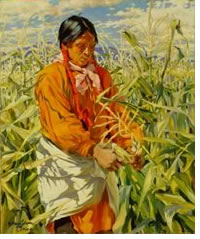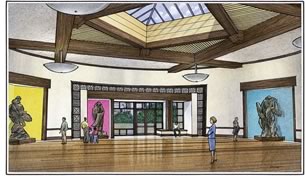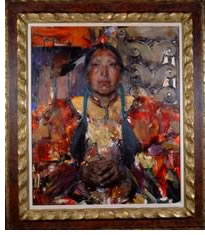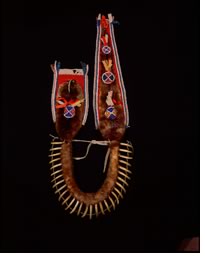

05/2005
New wing expands museum’s collection
by Russell Boniface
 The Eiteljorg Museum of American Indians and Western Art in downtown
Indianapolis, by Browning, Day, Mullins, Dierdorf Architects, will debut
its new Perelman Wing on June 11 as part of the museum’s $40.7
million “Eye on the Future” campaign to enlarge the museum’s
collection. The 45,000-square-foot Perelman Wing will feature three new
galleries, classrooms, a library, a technology lab, one sculpture court,
gardens, and plenty of open space. The addition will also double the
Eiteljorg’s public space, allowing the museum to display more of
its collection, hold special events, and provide guests with hands-on
learning. The addition is named for Mel and Joan Perelman, who donated
$5 million to the Eiteljorg Museum and have supported the Eiteljorg Museum
both financially and with artwork from their collection.
The Eiteljorg Museum of American Indians and Western Art in downtown
Indianapolis, by Browning, Day, Mullins, Dierdorf Architects, will debut
its new Perelman Wing on June 11 as part of the museum’s $40.7
million “Eye on the Future” campaign to enlarge the museum’s
collection. The 45,000-square-foot Perelman Wing will feature three new
galleries, classrooms, a library, a technology lab, one sculpture court,
gardens, and plenty of open space. The addition will also double the
Eiteljorg’s public space, allowing the museum to display more of
its collection, hold special events, and provide guests with hands-on
learning. The addition is named for Mel and Joan Perelman, who donated
$5 million to the Eiteljorg Museum and have supported the Eiteljorg Museum
both financially and with artwork from their collection.
 “Our mission is to inspire an appreciation and understanding of
the art, history, and cultures of the American West and the indigenous
peoples of North America,” says John Vanausdall, president and
CEO of the Eiteljorg Museum. “The new Perelman Wing will allow
us to pursue our mission as never before.”
“Our mission is to inspire an appreciation and understanding of
the art, history, and cultures of the American West and the indigenous
peoples of North America,” says John Vanausdall, president and
CEO of the Eiteljorg Museum. “The new Perelman Wing will allow
us to pursue our mission as never before.”
Native American and Western art find a home
The Eiteljorg Museum of American Indians and Western Art opened in 1989
in Indianapolis’ White River State Park along the Indianapolis
Central Canal. The 73,000-square-foot museum is set within a large
round base designed to represent a kiva, the sacred circular space
that was part of Indian pueblo communities. It is the only museum in
the Midwest to combine Native American and Western art and artifacts.
Says Vanausdall, “The museum captures the very history and spirit
of the region—the confluence of Native American, Hispanic, and
Anglo cultures that is the Southwest.”
 The
Native American collection presents the work of native artists from all
regions of North America, particularly the Plains and Southwest, with
a sampling of pieces from almost every tribal group. The American Western
collection spans the early 19th century to the present and includes art
depicting life west of the Mississippi. During his lifetime, Indianapolis-born
Harrison Eiteljorg, the museum’s late founder, businessman, and
philanthropist, traveled often to Taos, N.M., developing a kinship with
the native Pueblo Indians and acquiring items of their hand-crafted art.
Eventually, he added to his collection the holdings of the now-defunct
Museum of Indian Heritage.
The
Native American collection presents the work of native artists from all
regions of North America, particularly the Plains and Southwest, with
a sampling of pieces from almost every tribal group. The American Western
collection spans the early 19th century to the present and includes art
depicting life west of the Mississippi. During his lifetime, Indianapolis-born
Harrison Eiteljorg, the museum’s late founder, businessman, and
philanthropist, traveled often to Taos, N.M., developing a kinship with
the native Pueblo Indians and acquiring items of their hand-crafted art.
Eventually, he added to his collection the holdings of the now-defunct
Museum of Indian Heritage.
Construction on the Perelman Wing began in December 2003. Architect Jonathan Hess, AIA, designed both the original Eiteljorg Museum, inspired by the architecture forms of Indian pueblo communities, and its new Perelman Wing. Hess is an executive vice president at the Indianapolis-based firm Browning, Day, Mullins, Dierdorf Architects. Hess’s work includes the Indianapolis Museum of Art and additions to the Children’s Museum of Indianapolis. “The expansions to the museum represented a challenge for us to look anew and afresh at what we had originally designed some 17 years ago,” Hess says. “The original context of our construction had changed with the further development of White River State Park as well as the implementation of the historic canal, which defines the site to the north.”
 In
addition to the three new galleries, the new wing will house the Allen
Whitehill Clowes Sculpture Court, a circular space illuminated by skylights
for Native American drum groups, operas, lectures, and the display of
monumental sculptures, including Allan Houser’s Morning
Prayer (a bronze sculpture of an Apache serenely murmuring the
daily prayer). “The placement and expression of the expansion responds
to the state capitol through placing the new Alan Whitehill Clowes Sculpture
Court on axis with the state house,” Hess explains.
In
addition to the three new galleries, the new wing will house the Allen
Whitehill Clowes Sculpture Court, a circular space illuminated by skylights
for Native American drum groups, operas, lectures, and the display of
monumental sculptures, including Allan Houser’s Morning
Prayer (a bronze sculpture of an Apache serenely murmuring the
daily prayer). “The placement and expression of the expansion responds
to the state capitol through placing the new Alan Whitehill Clowes Sculpture
Court on axis with the state house,” Hess explains.
The 6,000-square-foot Nina-Mason Pulliam Education Center will be a resource center and library to allow students and visitors to explore the art, history, and cultures of the American West and native peoples of North America in a hands-on setting. The center will also house two visual and performing-arts studios, technology studio, and outdoor learning center.
Designing a wing of fancy
Before designing the museum, Eiteljorg and Hess traveled to Arizona and
New Mexico to study the land, architecture, and people of the Southwest.
Hess was inspired by the Indian pueblos of northern New Mexico, especially
the apartment-like dwellings constructed of adobe mud bricks. The structures
are the same today as they have been for several hundred years and
served as inspiration for much of the design of the museum, as well
as for the materials.
 In keeping with the design of the museum itself, the Perelman Wing maintains
the Southwestern motif. The exterior—three acres of gardens and
plazas along the downtown Central Canal—is composed of nearly 12,000
pieces of hand-cut, honey-colored Minnesota dolomite, which is already
prominent on the face of the museum. The dolomite is coupled with
plum-colored sandstone to create the feel of a Southwestern Pueblo. Native
plantings and indigenous trees, such as river birch, red oak, and sugar
maple, soften the stone and hardscape.
In keeping with the design of the museum itself, the Perelman Wing maintains
the Southwestern motif. The exterior—three acres of gardens and
plazas along the downtown Central Canal—is composed of nearly 12,000
pieces of hand-cut, honey-colored Minnesota dolomite, which is already
prominent on the face of the museum. The dolomite is coupled with
plum-colored sandstone to create the feel of a Southwestern Pueblo. Native
plantings and indigenous trees, such as river birch, red oak, and sugar
maple, soften the stone and hardscape.
 A discovery garden along a curvilinear path is part of the open space.
A separate festival space for events has permanent in-ground anchors
for tenting. “The architecture of the addition uses the original
design palette but attempts to add a more intimate, pedestrian scale,” Hess
says. “The site development creates spaces along the canal to welcome
visitors while also providing spaces for art and social functions.” Also
featured in this space will be a circular garden called “Symbols
of the Universe,” designed with Native input. It showcases symbols
universal to all indigenous tribes. And the Christen Dean Family Terrace
will overlook the museum’s garden along the Indianapolis Central
Canal.
A discovery garden along a curvilinear path is part of the open space.
A separate festival space for events has permanent in-ground anchors
for tenting. “The architecture of the addition uses the original
design palette but attempts to add a more intimate, pedestrian scale,” Hess
says. “The site development creates spaces along the canal to welcome
visitors while also providing spaces for art and social functions.” Also
featured in this space will be a circular garden called “Symbols
of the Universe,” designed with Native input. It showcases symbols
universal to all indigenous tribes. And the Christen Dean Family Terrace
will overlook the museum’s garden along the Indianapolis Central
Canal.
The interior design of warm earth tones, stone, and rich mahogany trim continues the Southwestern theme. The galleries are floored with stained oak. The Gathering Place, a subdued version of the museum’s majestic Grand Hall, features a winding cedar staircase that offers a 360-degree view of the famed Indianapolis Totem Pole, which is 34 feet high and weighs in at 1.9-tons. The heavy timber assembly of the Gathering Place meets exterior wavy zinc canopies, complementing the totem pole.
 Ribbon cutting
Ribbon cutting
The grand opening of the Perelman Wing will be held June 11–12. Musical
performances will celebrate the event and include bluegrass, folk,
western, tejano, and salsa music. Storytelling cowboys will also be
on hand. Visitors will be able to watch demonstrations of Native American
and Western culture and artwork and take walk-through tours. There
will even be a tipi raising.
Vanausdall is very grateful to the Perelmans for their support. “Every arts organization needs a Mel and Joan Perelman. Their enthusiasm helps us create excitement about exhibitions and events that people in the Midwest have asked us to present,” he says, adding that the museum is “immensely grateful to all those who made contributions—large and small—to the ‘Eye on the Future’ campaign. The newly expanded museum is a jewel box that has become a visual icon of the Indianapolis landscape.”
Copyright 2005 The American Institute of Architects.
All rights reserved. Home Page ![]()
![]()
